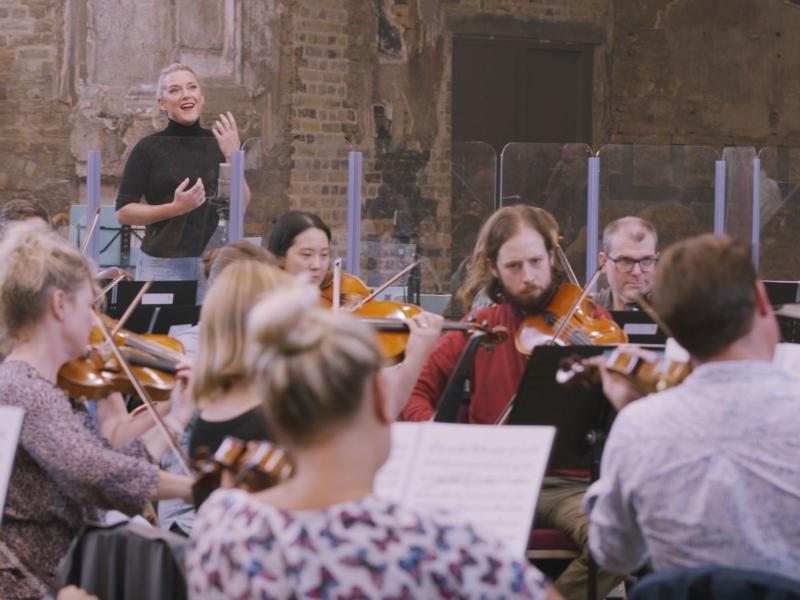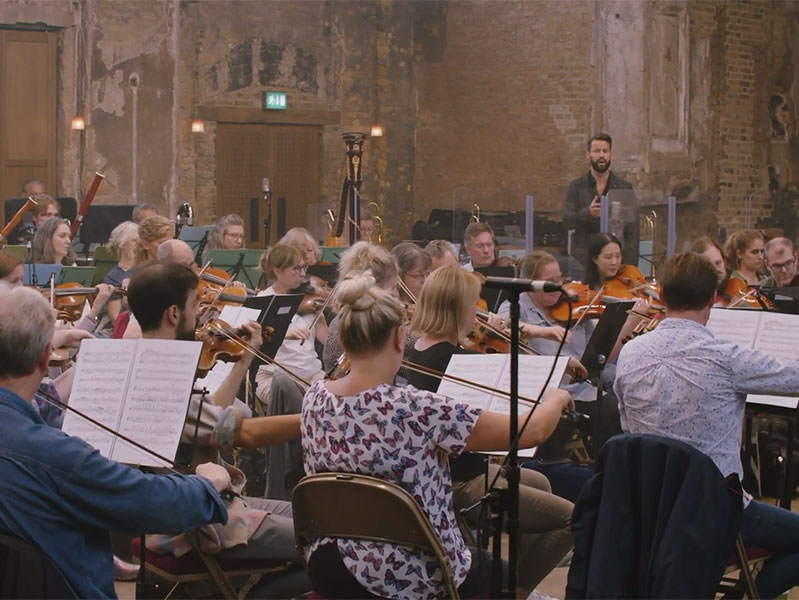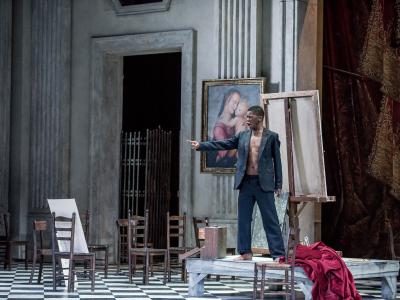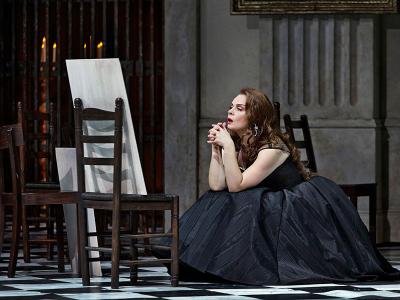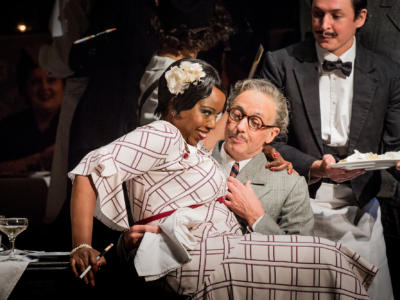Discover Tosca
Tosca is a roller coaster story of love, lust, murder and political intrigue. With Puccini‘s richly romantic score, it is one of the world’s most loved operas.
A tragic story of passion and jealousy, it tells the story of the tempestuous opera singer Floria Tosca, as she fights to save her lover Cavaradossi from the sadistic police chief Scarpia.
Tosca Synopsis by Director Christof Loy
These are turbulent times in Rome.
A newly-founded free republic, which had overthrown the aristocracy’s supremacy, has been dissolved – once again the royalists have prevailed. Queen Maria-Carolina now rules Rome, allowing her chief of police to mercilessly arrest and execute her opponents, often without a trial.
The famed opera singer Floria Tosca’s lover Mario Cavaradossi, a painter, is among the opponents.
Act I
Just a few hours before his execution, the political refugee Cesare Angelotti escapes from Castel Sant’Angelo, the state prison. He finds refuge in a church, where his family owns a private chapel.
His sister, the beautiful Marchesa Attavanti, has planned an escape for him, hiding the chapel key and women’s clothes for a disguise. In the same church, the painter Cavaradossi is working on a portrait of Maria Magdalena with an assistant. Inspired by Attavanti’s frequent visits to the church, he uses her face in the painting.
When Cavaradossi discovers the fugitive in the church, he quickly sees that they are politically like-minded and gives him the food that the Sacristan had prepared for his lunch break. When Tosca enters the church to make an appointment for the evening with her lover, Cavaradossi hides Angelotti in the chapel. Cavaradossi loves Tosca beyond measure, but because she is a devout Catholic, singer and figurehead for the royalist system, he’s decided to hide his political activities from her.
Sensing that something is wrong, Tosca thinks that Cavaradossi has met with another woman in the church, but she soon accepts his sincere affirmations of love. Her jealousy, however, flares as she recognises the face of Attavanti in the painting of Maria Magdalena. Once again, he manages to dispel her doubts about his loyalty, and she leaves the church after they have reconciled.
Now Cavaradossi can turn his focus back to Angelotti’s escape. He offers to let him stay in his villa, the secret love-nest he shares with Tosca. In case of a search, there is a safe hiding place in the garden, in a niche deep inside the well. As Angelotti prepares to leave, the cannons of Castel Sant’Angelo fire, signalling that his escape has been discovered. Cavaradossi then decides to take it upon himself to get the fugitive to safety.
Meanwhile, the church is being prepared for a solemn ceremony. The conservative party has beaten its opponent, Napoleon, in a decisive military battle and all of Rome is to celebrate the event. God will be thanked for this victory, and a Te Deum is organised.
Tosca has been ordered to attend a gala performance for the queen in the evening, and she wants to tell Cavaradossi that she must cancel their date – but instead of Cavaradossi, she finds the chief of police, Baron Scarpia, in the church. He has searched the church and has found evidence that Cavaradossi helped the fugitive. In their hasty departure, Angelotti had forgotten a part of his disguise: a fan with the coat of arms of Attavanti. Scarpia confiscates it, realising that the politically suspicious Cavaradossi is the painter who works in the church.
Scarpia’s encounter with Tosca is beneficial to him in two ways. On the one hand, he is a fervent admirer of the singer; on the other, he believes that the fugitive can be found through her and her lover. Scarpia knows that his own head is at stake if Angelotti is not captured and executed by the next morning – he also knows he can arouse Tosca’s jealousy by pretending to have found the fan next to the painter’s easel, causing her to suspect that her beloved is having an affair with Attavanti.
Tosca sets out to confront Cavaradossi, with Scarpia’s people tailing her. Scarpia is euphoric and feels victorious – both over his political opponents and Tosca, whom he desires.
Interval of 20 minutes
Act II
A few hours later, we find Scarpia in his quarters at the Palazzo Farnese, where Tosca will celebrate the victory over Napoleon with a cantata. Bad news awaits him: his agent Spoletta has followed Tosca to the villa, but he has only found Cavaradossi. Cavaradossi is taken into custody on suspicion of helping the fugitive escape, but denies the allegations made against him. When Tosca arrives after her performance at Scarpia’s request, Scarpia orders Cavaradossi to be interrogated. Tosca realises that Cavaradossi is about to be forced to testify under torture. Scarpia makes it clear to Tosca that she can shorten his torture by co-operating. Though she tries to resist, she can’t withstand listening to Cavaradossi’s cries of pain and tells Scarpia about the hiding place. Scarpia immediately halts the torture, and with relish he orders the arrest of Angelotti in front of the two lovers. Cavaradossi realises that Tosca has betrayed him and curses her.
At the same time, Scarpia receives bad news from his valet Sciarrone: the victory over Napoleon was a false report and the royal army has been beaten. Cavaradossi strikes up a revolutionary song and insults Scarpia, calling him a tyrant and a murderer. With this, he seals his death sentence and Scarpia orders him to be taken away. Tosca remains, knowing that only she can save her lover’s life. The wealthy singer attempts to negotiate a ransom, but Scarpia makes it clear that he is not interested in money – his price is Tosca herself. Impudent and desperate in his greed, Scarpia tries to seize her. Finally, Tosca accepts the deal. Scarpia then orders Spoletta to perform a fake execution of Cavaradossi the next morning. Tosca wants to hand the execution order to Cavaradossi herself and explain the situation to him, as well as be present at the execution. She also forces Scarpia to sign a letter of safe conduct for her and Cavaradossi, so they can leave the area the next day. Once she is alone with Scarpia, she stabs him with a knife as he embraces her, grabs the letter and leaves the room.
Interval of 20 minutes
Act III
Cavaradossi is awaiting his execution. He listens to the sounds of the awakening Rome, and memories and dreams stir within him. Then the bitter reality of observing the signing of his execution order hits him. He regrets cursing Tosca and writes her a farewell letter. As he begins to slip into another daydream, he is startled by Tosca standing in front of him with the pass to freedom, signed by Scarpia himself. Still shaken by the past few hours, she describes the murder of Scarpia to her lover. Now she only dreams of one thing: a future in freedom, united with her lover far away in another country.
Like a director, she explains the fake execution to Cavaradossi, in which he must play along like an actor in a drama. The curtain rises to this melodrama staged by Tosca – but she realises too late that her dream was nothing but a dream. The execution is not fake, the blood is real, and Cavaradossi is dead. Scarpia has betrayed her. Tosca jumps to her death from atop Castel Sant’Angelo.
Tosca FAQs
How long is Tosca?
A performance of Tosca at the ENO’s London Coliseum is roughly 2hrs 40mins, which includes 2 20-minute intervals.
Who wrote Tosca?
Tosca was written by Italian composer Giacomo Puccini.
With a dramatic story line and Puccini’s richly romantic score, Tosca is one of the world’s most famous operas.
What is Tosca about?
Set entirely within 48 hours, Tosca happens in the balmy days of mid-June 1800, in the years shortly after the French Revolution. Napoleon, fresh from victory in France, invaded Rome without opposition 1798, setting up a republic and exiling the reigning Pope, leading to the Church entering a time of turmoil.
Though our tale may follow the feisty Tosca, when our opera opens we meet the lone artist Cavaradossi, our titular heroine’s lover, and a painter by trade. When Angelotti, escaped convict and political dissident, stumbles into the church Cavaradossi is working in, the artist offers aid and a place to hide from chief of police, the Baron Scarpia.
Shortly after, the villainous Scarpia enters, knowing that his prey was here shortly beforehand, and that his artist friend is implicit in aiding Angelotti. Sensing an opportunity when opera singer (and Cavaradossi’s lover) Tosca arrives, he begins a game of cat and mouse with the primadonna that leads to disaster. Who will survive? Will Tosca get her man? Will Scarpia recapture his prey?



